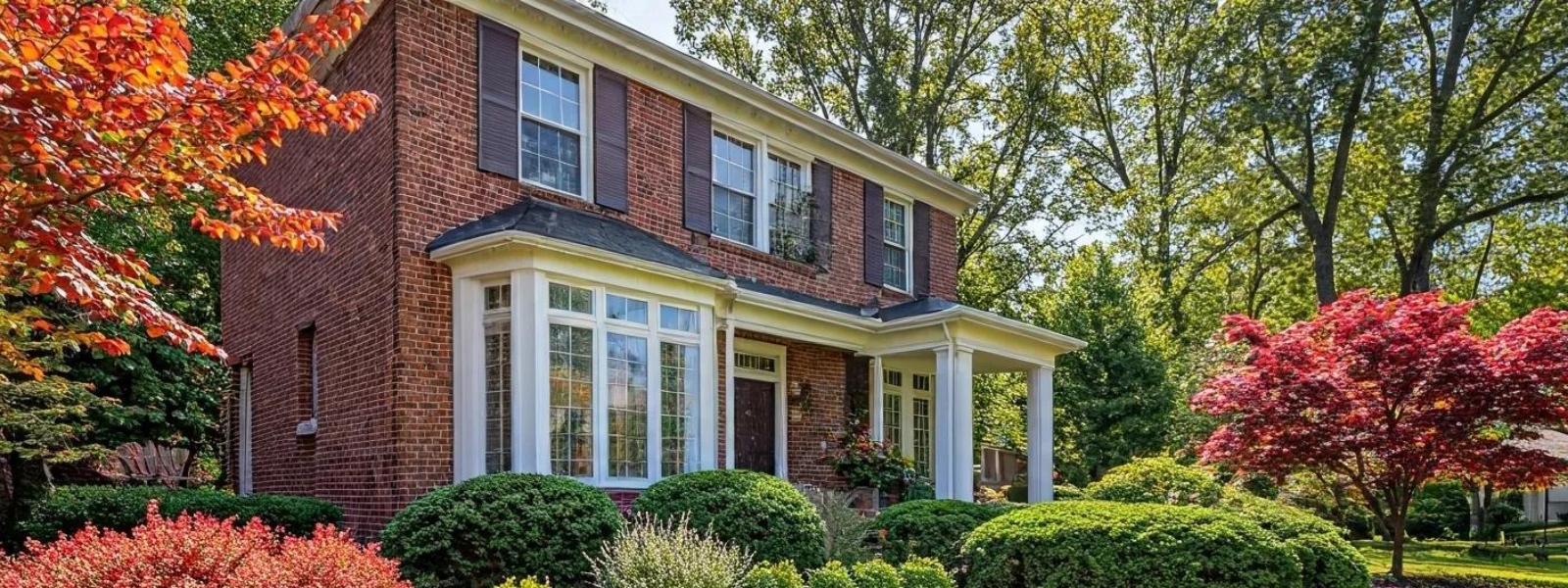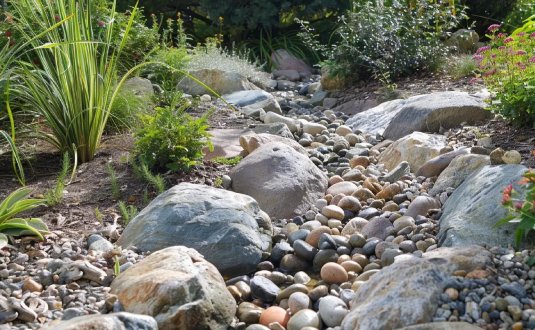Providing Best Services in Huntsville, AL
Providing Best Landscaping Services in Huntsville, AL



.webp)
Fall Landscaping Tips Low Maintenance
Fall landscaping tips for low maintenance focus on efficient tasks that prepare yards for winter with minimal effort. Smart homeowners choose simple methods like proper mowing heights, native plant selection, and strategic mulching to reduce spring workload while maintaining attractive outdoor spaces.
What Makes Fall Lawn Care Low Maintenance?
Fall lawn care becomes low maintenance when you focus on three core tasks: proper mowing, strategic fertilizing, and efficient leaf management. These activities prepare grass for winter dormancy and reduce spring maintenance needs.
How Should You Cut Grass for Winter?
Cut grass to 1¼ inches for the final mow before winter. This height prevents disease formation and allows fallen leaves to blow across the lawn surface instead of creating thick mats.
Grass produces food in the upper blade sections. Cutting too short removes the plant's energy source and weakens root systems. Continue mowing until growth stops completely based on grass activity, not calendar dates.
What Is the Easiest Way to Handle Fallen Leaves?
Use a mulching mower on thin leaf layers and rake only heavy accumulations onto plastic tarps. Light leaf coverage breaks down naturally and feeds lawn grass through decomposition.
Thick leaf piles block sunlight and create fungal problems. Remove these heavy accumulations by raking onto tarps for easy transport to compost areas or disposal sites.
When Should You Apply Fall Fertilizer?
Apply fall fertilizer six weeks before the first expected frost date. Research from the University of Massachusetts shows that nutrients absorbed in fall get stored over winter to support spring growth.
Use high-phosphorus fertilizer ratios like 12-25-12. Phosphorus promotes root development instead of leaf growth that cold weather could damage. Cool-season grasses like fescue and bluegrass benefit most from fall feeding programs.
Which Plants Require Minimal Fall Care?
Native plants and climate-adapted species require minimal fall care because they evolved to thrive in local soil and weather conditions. These plants resist diseases, tolerate drought, and attract beneficial wildlife without constant maintenance.
What Are the Best Low Maintenance Fall Plants?
Black-eyed Susans and purple coneflowers provide reliable fall color with minimal care requirements. These native perennials bloom from summer through fall, attract pollinators, and self-seed to expand coverage areas naturally.
Alabama gardeners succeed with these proven varieties:
- American beautyberry handles drought and flooding
- Scarlet sage attracts hummingbirds continuously
- Butterfly weed needs zero fertilizer applications
- Tickseed blooms in poor soil conditions
How Do Evergreen Shrubs Reduce Maintenance?
Evergreen shrubs eliminate fall leaf cleanup while providing year-round structure and color. These plants maintain foliage through winter months and require minimal pruning or pest control.
Low-maintenance evergreen options include boxwood for formal landscapes and dwarf conifers for textural interest. Holly varieties produce berries for wildlife while abelia offers fragrant flowers from spring through fall.
Why Choose Ground Cover Over Grass?
Ground cover plants reduce mowing requirements and spread naturally to suppress weeds. These alternatives handle foot traffic better than grass and adapt to challenging growing conditions like slopes or shade.
Effective ground covers include liriope for drought tolerance and wild bergamot for quick spreading. Creeping thyme releases fragrance when walked on and produces small flowers for pollinators.
What Are the Most Efficient Fall Cleanup Methods?

Efficient fall cleanup focuses on removing diseased plant material and applying mulch rather than achieving perfect tidiness. This approach prevents pest problems while reducing labor time and maintaining soil health.
Which Plant Materials Should You Remove?
Remove tired annual plants and diseased foliage that harbor overwintering pests and diseases. These materials serve as infection sources for next year's growing season and should go in trash rather than compost.
Cut spent perennial stems to ground level to redirect plant energy into root systems. Leave seed heads on native plants like coneflowers because birds consume seeds through winter months.
How Does Mulching Save Future Work?
Apply 2-4 inches of organic mulch to suppress weeds, retain soil moisture, and regulate soil temperature. Mulch reduces watering needs by 70% according to Alabama Cooperative Extension research.
Wood chips and pine straw work better than shredded leaves because they decompose slowly and stay in place during heavy rains. Keep mulch 2-3 inches away from plant stems to prevent pest problems.
What Pruning Tasks Matter Most?
Remove dead, damaged, and crossing branches for plant health and safety. Most native plants develop natural forms that need minimal pruning intervention beyond basic maintenance.
Cut diseased limbs close to the trunk without cutting flush against bark. Leave pruning wounds exposed because wound dressings actually slow healing processes.
How Do You Create Water-Efficient Fall Strategies?
Water-efficient fall strategies rely on natural rainfall patterns and deep, infrequent watering when needed. Cool weather and seasonal precipitation reduce irrigation needs compared to summer requirements.
When Should You Adjust Watering Schedules?
Reduce watering frequency as temperatures drop and rainfall increases in fall months. Established lawns need 1 inch of water weekly during active growth but may need watering only every 10-14 days as growth slows.
Check soil moisture at 2-3 inch depth with your finger. Water deeply when soil feels dry at this level rather than following fixed schedules that waste water and promote shallow root growth.
What Irrigation Systems Work Best?
Drip irrigation and soaker hose systems deliver water directly to root zones with minimal evaporation loss. These systems operate automatically once programmed and reduce labor time while conserving water.
Install timers or smart controllers for efficient watering schedules. Early morning watering reduces evaporation rates and allows plants to absorb moisture before heat stress occurs.
Which Fall Tasks Should You Skip?
Skip excessive fertilizing, complete debris removal, and planting non-adapted species to save time and prevent problems. These common mistakes waste effort without improving landscape health or appearance.
Why Avoid Over-Fertilizing in Fall?
Excessive fall fertilizing promotes pest problems and reduces plant cold tolerance. Native plants adapted to local soils develop stronger root systems without supplemental nutrition according to University Extension research.
High nitrogen applications encourage rapid leaf growth that attracts insects and requires more frequent watering. Apply fertilizer only when soil tests indicate specific nutrient deficiencies.
What Cleanup Tasks Are Unnecessary?
Leave beneficial plant debris like seed heads and light leaf coverage for wildlife habitat and natural mulch. Birds depend on native plant seeds through winter months while decomposing leaves improve soil organic matter.
Focus removal efforts on diseased materials and safety hazards rather than cosmetic perfection. Natural landscapes function better with some organic debris left in place.
How Do You Design for Long-Term Low Maintenance?
Design for long-term low maintenance by grouping plants with similar needs and incorporating hardscape elements that require no care. This approach reduces daily maintenance while creating attractive, functional outdoor spaces.
How Should You Group Plants for Easy Care?
Group plants by water and sunlight requirements to simplify irrigation and reduce plant stress. This strategy allows targeted care for each zone rather than trying to meet conflicting needs across mixed plantings.
Place drought-tolerant species in sunny, well-drained locations while moisture-loving plants go near downspouts or naturally wet areas. Consider drainage solutions for persistent water problems.
What Role Does Hardscaping Play?
Hardscaping elements like patios, walkways, and retaining walls eliminate maintenance requirements while adding structure to landscapes. These features never need watering, fertilizing, or pest control treatments.
Stone and brick materials work well in Southern climates and complement native plant selections. Landscape edging defines planting areas and reduces maintenance at borders between different landscape zones.
How Do You Plan for Four-Season Interest?
Plan four-season interest by selecting plants with different bloom times, fall colors, and winter structure. This approach maintains visual appeal year-round without requiring seasonal replanting.
Spring bulbs lead to summer perennials, followed by fall-blooming asters and winter evergreen structure. Small ornamental trees provide fall color without creating excessive leaf cleanup because of their compact size.
When Should You Complete Fall Landscaping Tasks?
Complete major fall landscaping tasks between September and November when soil temperatures remain above 40°F but air temperatures cool enough for root establishment. This timing window allows plants to develop strong root systems before winter dormancy.
What Is the Best Fall Planting Schedule?
Plant new shrubs and trees in early fall when soil moisture increases and heat stress decreases. September through November provides optimal conditions for root development according to extension service recommendations.
Cool, moist soil conditions help newly planted specimens establish quickly. Fall-planted trees show more vigorous spring growth compared to spring-planted specimens that struggle with summer heat stress.
When Should You Stop Major Maintenance?
Stop major lawn maintenance like aeration and overseeding by the end of September to allow adequate establishment time. Plants need 45 days minimum to develop sufficient root systems for winter survival.
Continue basic tasks like mowing until grass growth stops but avoid late-season fertilizing that could promote tender growth susceptible to frost damage.
Should You Handle Fall Tasks Yourself or Hire Professionals?
Handle simple tasks like raking, basic pruning, and mulching yourself while hiring professionals for specialized work requiring equipment or expertise. This division maximizes efficiency while controlling costs.
Which Tasks Work Well for DIY Approach?
DIY tasks include leaf removal, light pruning, mulch application, and watering adjustments. These activities require basic tools and techniques that most homeowners can master quickly.
Basic maintenance keeps costs low while allowing hands-on learning about your specific landscape needs. Start with low-maintenance plants for Alabama to build confidence and experience.
When Do You Need Professional Help?
Professional help becomes necessary for major tree work, irrigation system installation, grading projects, and large-scale plant installations. These jobs require specialized equipment, licensing, or extensive plant knowledge.
Landscaping design services create comprehensive plans that reduce future maintenance through proper plant selection and site preparation. Professional installation often includes warranties and ongoing support.
Final Thoughts
Low-maintenance fall landscaping succeeds through strategic plant selection, efficient task timing, and focus on essential activities that prevent problems. Native plants adapted to local conditions require less water, fertilizer, and pest control while providing better wildlife habitat than non-native alternatives.
Start with one area this fall rather than attempting complete landscape renovation. Replace high-maintenance grass with ground cover or install native plants that thrive without constant attention.
The goal is sustainable beauty that fits your available time and energy. Smart fall preparation reduces spring workload while creating attractive outdoor spaces that function well year-round.
Ready to reduce your landscape maintenance requirements? Contact our team to discuss low-maintenance design options that match your specific needs and site conditions.
Stay Connected and Inspired
Get the latest landscaping tips, seasonal care guides, and exclusive offers delivered straight to your inbox. Don’t miss out on expert advice and ideas to transform your outdoor spaces.
Sign Up for Our Newsletter Today!


Your Next Idea Awaits
Stay inspired with our latest landscaping tips and trends.
.webp)
.webp)

.webp)
.webp)
.webp)
.webp)
.webp)

.webp)








.webp)
.webp)





